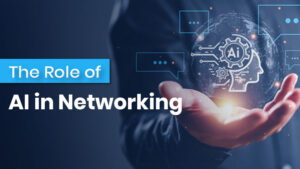
The Role of AI in Networking
The Role of AI in Networking Introduction The accelerated developments in Artificial Intelligence (AI) have revolutionized several sectors, such as healthcare, finance, and industry.
🔥 Limited Time Offer 🔥 Get the Premium Monthly Plan for just $11.99 $19.99. Use code UPSKILLNOW and unlock exclusive benefits 👉Subscribe Now!

The Role of AI in Networking Introduction The accelerated developments in Artificial Intelligence (AI) have revolutionized several sectors, such as healthcare, finance, and industry.

Managed vs. In-House IT: What’s Right for Your Business? Introduction Technology is no longer a support function but a key enabler of innovation, scalability, and

Google Workspace vs. Microsoft 365: Which is Better for Your Team? Introduction Choosing the right productivity suite is essential for any business aiming to
Table of Contents
In today’s digital age, where applications are an integral part of our daily lives and business operations, ensuring their security has never been more critical. Application security encompasses the measures and practices designed to protect applications from threats and vulnerabilities throughout their lifecycle. This blog delves into the core concepts of application security, explores essential tools, and highlights best practices to help organizations safeguard their applications effectively.
Ready to enhance your application security skills? Visit https://ipspecialist.net/ for expert-led training and hands-on labs. Master the art of securing applications and stay ahead in the cyber landscape. Sign up today and become a security champion!
Application security is the process of making applications more secure by finding, fixing, and enhancing their security features. This includes not only protecting applications from external threats but also addressing vulnerabilities that could be exploited from within. The primary goal is to prevent unauthorized access, data breaches, and other security threats that can compromise the integrity, confidentiality, and availability of an application.
Here are the most common application security categories:
SAST helps detect code flaws by analyzing the application source files for root causes. It enables comparing static analysis scan results with real-time solutions to quickly detect security problems, decrease the mean time to repair (MTTR), and troubleshoot collaboratively.
DAST is a proactive testing approach that simulates security breaches on a running web application to identify exploitable flaws. These tools evaluate applications in production to help detect runtime or environment-related errors.
IAST utilizes SAST and DAST elements, performing analysis in real-time or at any SDLC phase from within the application. IAST tools get access to the application’s code and components, which means they achieve the in-depth access needed to produce accurate results.
RASP tools work within the application to provide continuous security checks and automatically respond to possible breaches. Common responses include alerting IT teams and terminating a suspicious session.
MAST tools test the security of mobile applications using various techniques, such as performing static and dynamic analysis and investigating forensic data gathered by mobile applications. MAST tools help identify mobile-specific issues and security vulnerabilities, such as malicious WiFi networks, jailbreaking, and data leakage from mobile devices.
A WAF solution monitors and filters all HTTP traffic passing between the Internet and a web application. These solutions do not cover all threats. Rather, WAFs work as part of a security stack that provides a holistic defense against the relevant attack vectors.
WAF works as a protocol layer seven defense when applied as part of the open systems interconnection (OSI) model. It helps protect web applications against various attacks, including cross-site-scripting (XSS), SQL injection (SQLi), file inclusion, and cross-site forgery (CSRF).
A Cloud-Native Application Protection Platform (CNAPP) centralizes the control of all tools used to protect cloud-native applications. It unifies various technologies, such as cloud security posture management (CSPM) and cloud workload protection platform (CWPP), identity entitlement management, automation and orchestration security for container orchestration platforms like Kubernetes, and API discovery and protection.
The following best practices should help ensure application security.
An organization must have full visibility over its assets to protect them. The first step towards establishing a secure development environment is determining which servers host the application and which software components it contains.
For example, Equifax could have prevented the breach by patching an Apache Struts component in a customer web portal, but they were unaware they were using the vulnerable component.
The modern, fast-paced software development industry requires frequent releases—sometimes several times a day. Security tests must be embedded in the development pipeline to ensure the Dev and security teams keep up with demand. Testing should start early in the SDLC to avoid hindering releases at the end of the pipeline.
Understanding the existing development process and relationships between developers and security testers is important to implement an effective shift-left strategy. It requires learning the teams’ responsibilities, tools, and processes, including how they build applications. The next step is integrating security processes into the existing development pipeline to ensure developers easily adopt the new approach.
The CI/CD pipeline should include automated security tests at various stages. Integrating security automation tools into the pipeline allows the team to test code internally without relying on other teams so that developers can fix issues quickly and easily.
After listing the assets requiring protection, it is possible to start identifying specific threats and countermeasures. A threat assessment involves determining the paths attackers can exploit to breach the application.
With the potential attack vectors identified, the security team can evaluate its existing security controls for detecting and preventing attacks and identify new tools to improve the company’s security posture.
However, when evaluating existing security measures and planning a new security strategy, it’s important to have realistic expectations about the appropriate security levels. For instance, even the highest level of protection doesn’t completely block hackers.
Not every user in an organization requires the same access privileges. Restricting access to data and applications on a need-to-know basis is a key security best practice. There are two main reasons for limiting privileges:
Web Application Security Risks: OWASP Top 10
Software applications are vulnerable to numerous threats. The Open Web Application Security Project (OWASP) identifies the most critical threats that commonly affect applications in production.
Broken access control allows attackers to gain unauthorized access and privileges. Common issues include:
To remediate this issue, implement strong access control mechanisms that clearly define and isolate each role’s privileges.
Cryptographic failures (previously referred to as “sensitive data exposure”) occur when data is not adequately protected in transit and at rest. This can expose passwords, health records, credit card numbers, and personal data.
Such failures can lead to non-compliance with data privacy regulations, such as the EU General Data Protection Regulation (GDPR), and financial standards like PCI Data Security Standards (PCI DSS).
Injection vulnerabilities enable attackers to send malicious data to a web application interpreter, causing it to be compiled and executed on the server. SQL injection is a common form of this vulnerability.
| Trend | Description |
| AI in Application Security | AI will be used extensively for both developing and exploiting vulnerabilities. Secure development practices will leverage AI to personalize user experience and enhance security, while attackers will use AI to bypass defenses and steal data. |
| Focus on Mobile App Security | Mobile applications will continue to be a prime target for attackers. Organizations will need to implement robust security measures to protect against malware, spoofing, phishing, and other attacks. |
| Zero Trust Architectures | As traditional perimeter-based security models become insufficient, zero-trust architectures will be widely adopted. This approach assumes no inherent trust and requires continuous validation of all users and devices. |
| Enhanced API Security | APIs are critical components of modern applications but can also be security vulnerabilities. Organizations will prioritize API security by implementing strong authentication, authorization, and encryption measures, along with regular testing and monitoring. |
| Prioritization of Vulnerability Remediation | With the vast number of security tools available, effectively prioritizing which vulnerabilities to address first remains a major challenge. Security teams will need to develop strategies to streamline this process. |
Application security is a multifaceted discipline that requires a proactive and comprehensive approach to protect applications from evolving threats. By understanding core concepts, leveraging essential tools, and adhering to best practices, organizations can significantly enhance the security posture of their applications. In an era where cyber threats are ever-present, investing in application security is not just a best practice—it’s a necessity.
Shifting security left means integrating security testing early in the SDLC, reducing vulnerabilities and costs associated with fixing issues later in the development process.
By implementing automated security testing tools, conducting regular threat assessments, and enforcing least-privilege access controls, organizations can maintain robust security across diverse application environments.
© 2025 All rights reserved | Privacy Policy | Terms and Conditions | Sitemap | Cookie Policy




